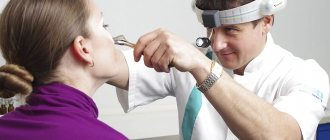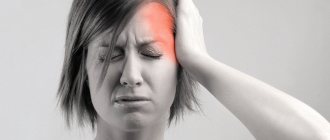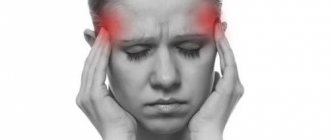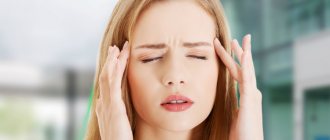In an “iron” vice: why does your head hurt?
In an “iron” vice: why does your head hurt?
Headache can be a symptom of various diseases, including dangerous ones. However, in most cases, headaches are not life-threatening.
cephalalgia, migraine, intracranial pressure, hypertension, treatment
Millions of people around the world suffer from headaches, which do not always come in mild attacks and are easily relieved with painkillers. Sometimes it can be unbearable, and women suffer from headaches more often than men.
What to do when the head is cast iron?
Headache is one of the most common symptoms. There is probably no person who has not experienced this type of pain at least once in his life.
We prescribe pills to ourselves and take them on the principle of “whatever will help,” without thinking that taking medications for headaches more often than three times a week can provoke a so-called medicinal headache. We put off going to the doctor, without thinking or little understanding of the consequences of a headache.
What is a tension headache? What headache can you not tolerate for a minute? How to treat headaches? We addressed these and other questions to Alexander Sergeevich Tuleninov, a radiologist at MRI Expert Yelets LLC.
- Why does my head hurt and what can be hidden behind the headache?
Headache can occur in patients regardless of age.
According to ICHD-2, headaches that do not have an organic cause are called primary. Secondary (symptomatic) are the result of organic damage to the brain or other structures of the head and neck area, as well as systemic diseases.
— Alexander Sergeevich, tell us more about primary headaches.
One of the most common types of primary headaches is tension headaches. If a patient complains of a “cast-iron head” (“feeling of a hoop”, “cast-iron helmet”), then this is probably the kind of pain we are talking about. Such pains - pressing, squeezing, are a response to muscle tension or psycho-emotional overstrain under acute or chronic stress. Depending on the spasm of certain muscles, the patient may have a headache in the forehead, temples or back of the head.
— What organic causes of headaches are most common?
Among the organic causes that cause headaches are head injuries (both acute and their consequences), inflammatory processes (meningitis, meningoencephalitis, etc.), and space-occupying formations (tumors). Vascular diseases also often manifest themselves as headaches.
Separately, headaches of extracerebral etiology can be distinguished. Such pain can result, for example, from osteochondrosis of the cervical spine. Such pain, both episodic and chronic, is more often unilateral, usually localized in the cervical-occipital region, and can radiate to the temple.
Headache can also occur due to extra-cerebral causes such as sinusitis, glaucoma, and dental diseases.
— We talked about different types of headaches and realized that not every headache, even a very severe one, hides a serious illness. What kind of headache should you be wary of?
If a patient experiences a headache that he describes as the worst pain of his life, urgent medical attention is necessary.
Pain that does not go away for several days, as well as headaches accompanied by neurological changes, for example, drooping lip folds, speech impairment, also require immediate medical intervention.
Headache, the intensity of which increases with coughing or changing body position, is also a concern.
— What should be the treatment for headaches and what specialty does a doctor deal with this category of patients?
If you have headaches, you should consult a neurologist.
Treatment for headaches depends on the causes that caused them and is complex. But any treatment must begin with diagnosis.
— What should a diagnosis for headaches include?
Mandatory diagnostic methods include blood pressure monitoring, general and biochemical blood tests. A test for liver enzyme markers is often prescribed.
Since headaches can be a mask for various diseases, an ophthalmologist, otolaryngologist or dentist may be involved in consultation.
Modern doctors are increasingly referring patients experiencing headaches to MRI diagnostics.
MRI of the brain is the primary research method for headaches, allowing to identify inflammatory processes, liquorodynamic disorders, congenital anomalies, the existence of which the patient did not suspect, and any space-occupying formations.
Carrying out MR angiography of the arteries and veins of the brain evaluates blood flow and also excludes or identifies both gross changes in the blood vessels of the brain that threaten life (such as aneurysmal dilatation), as well as stenosis and thrombosis.
To diagnose degenerative changes in the neck area, an MRI of the cervical spine is performed. In turn, MRI of the neck vessels will reveal stenoses that impair blood supply, resulting in headaches.
— Why undergo complex MRI diagnostics for headaches? If I have a headache, why do an MRI of the cervical spine?
As you can see, there are many reasons that lead to headaches. Therefore, a comprehensive study allows for the most informative diagnosis.
For example, an MRI of the brain, which clearly visualizes any space-occupying formations, does not show vessels, the pathology of which can lead to headaches. As for the neck, we previously said that banal osteochondrosis can cause severe, debilitating headaches for the patient. Therefore, there is a need for a separate MRI of the neck and its vessels. Thus, one study complements the other.
When carrying out MRI diagnostics aimed at identifying the causes of headaches, according to indications, it may be necessary to administer a contrast agent.
- Alexander Sergeevich, so what can you do to stop your head from hurting?
The correct solution in such a situation is to find a cause-and-effect relationship. Therefore, my advice will be banal - do not delay in seeing a doctor.
For reference:
Tuleninov Alexander Sergeevich – radiologist at MRI Expert Yelets LLC.
In 2014 he graduated from the Military Medical Academy named after. CM. Kirov with a degree in general medicine. Afterwards he completed training at the St. Petersburg Pediatric University at the Department of Medical Biophysics, specializing in radiology.
In operation since 2021.
Headache: what to do?
If the headache occurs no more than 5-10 times a month and is not caused by hypertension, trauma and other diseases, and is not accompanied by a change in consciousness, it can be relieved with non-steroidal anti-inflammatory drugs. In other cases, it is necessary to establish the cause of the headache and treat the disease of which it is a symptom.
Expert: Galina Filippova, Candidate of Medical Sciences, general practitioner Author: Anna Nagorskaya
The material uses photographs belonging to shutterstock.com
Signs of a headache due to physical muscle tension
The main manifestations of tension-type headache are squeezing, squeezing pain, weakness, fatigue, and irritability. The patient may complain of insomnia, lack of appetite and absent-mindedness. Pain intensifiers include loud noises, bright lights, combing hair, and wearing a hat.
Headache due to nervous tension. Predisposing factors are conflict situations, psychological stress, and depression. In this case, headaches are wave-like in nature, weakening (disappearing) when the person is distracted from the traumatic situation. For example, in nature, with friends, while watching a comedy, or on a trip, patients note a significant improvement in their general condition.
How to relieve tension headache symptoms? Psychotherapy sessions, relaxing massage, physiotherapy, yoga, auto-training will help.
The main manifestations of muscle tension headaches are: dull pain in the back of the head, tension in the neck and shoulder muscles, pressing pain in the temples. A hot shower, physical therapy and a relaxing massage of the collar area will help reduce pain.
Stiff neck - how to relieve muscle tension
The first symptoms of muscle stiffness appear in constant spasms, and a person may also feel aching pain in the back
. After working at the computer for a long time, in the evening you begin to feel achy and dizzy, possibly feeling faint. This result usually awaits any patient after constant muscle strain in the back and neck.
Muscle stiffness
To avoid the occurrence of unpleasant diseases such as osteochondrosis of the cervical spine
, or not encounter complications (for example, dangerous pathologies of the spine and blood circulation), it is worth giving your neck a rest from time to time. First of all, you need to pay attention to the position of the body:
- Shoulders should be down;
- The trapezius is relaxed;
They can be tense for various reasons. For example, due to fatigue or stress, stooping, constantly raised shoulders.
Important!
If the pain becomes unbearable, this indicates pinched nerves, the development of a hernia or other pathologies. In this case, you should immediately consult a qualified specialist.
Possible consequences
Just seven thin vertebrae must support the weight of the head. Thirty-two more muscles act to help the cervical vertebrae, which help keep the head straighter and protect blood circulation to the brain. Also in the cervical region is the center of blood supply to the whole body.
Thus, if the neck muscles are constantly in a tense state, the human body begins to “pull” in the shoulder and neck area, and a severe headache
. When this condition lasts for more than a year, the skin begins to age faster and wrinkles appear. Also, most likely, the patient suffers from radiculitis, and complications will only increase.
Useful exercises
Relieving muscle tension takes just a few simple steps. They will help get rid of pain.
- If your back is constantly slouched, straighten your shoulders, bring your chest forward;
- Raise and lower your shoulders several times;
- Next, relax your shoulder girdle and neck area as much as possible.
There is another effective way. It is considered medicinal and certainly has good results. First you need to completely relax your shoulder girdle and slightly raise the back of your head. You need to feel how the vertebrae are stretched. Next, resting your head on your chest, begin rubbing the collarbone area. Thus, breathing will become more free and your back will straighten.
Reducing the symptoms of osteochondrosis, which can also be caused by sedentary work, is very simple. You should place the palm of your left hand on your right shoulder, and, touching your neck with your thumb, begin to rub the area of the muscles that connect the neck and shoulder. Next, repeat the same action on the opposite side.
How to relieve tension
Raised shoulders, an elongated head, one leg crossed over the other, slouching - all these are typical mistakes of a person working at a computer.
Below are effective complexes that will help you easily get rid of nagging pain, stretch and relax stiff areas of muscle tissue and avoid overexertion.
If the head is pulled forward, it leaves its usual physiological state. As a result, the muscles of the chest and clavicular area lose their tone. The biggest problem is that soon this position will seem comfortable to you.
Also, all this can lead to the appearance of an intervertebral hernia, deterioration of the blood supply to the body, and other problems. To avoid this result, you should perform the presented exercises. They do not require a lot of time or effort, and you can do them at home, in the office, or even while driving.
Muscle stretching (standing)
To begin, take a comfortable position and try to completely relax every part of your body. Next, place one hand at the back of your head and the other on your chin. Pull your chin down and the back of your head up as much as possible. The neck will bend back, but you need to hold it. This exercise will help you easily relax tense neck muscles.
Stretching the neck area (excluding back support)
This exercise can be performed anywhere, even while sitting in the office. You need to sit on the very edge of the chair and transfer the entire mass of your torso to your buttocks. This will put your back in a slight neutral position if done correctly.
Next, you need to raise the back of your head, press your chin to your neck (to make a “double chin”). Stay in this position for at least ten seconds. Repeat three to four times. Don't forget about free, balanced breathing.
Stretching (leaning back)
This exercise emphasizes muscle stretching. It is also important because it helps to avoid imbalance. You need to pull your neck to the left. Then - to the right. Repeat similar movements back and forth.
Each time, fix your neck in this position for about ten to fifteen seconds. This exercise is repeated three times on each side.
Possible causes of spasms
Sometimes muscle stiffness can occur as a consequence of certain diseases. For example, osteochondrosis, intervertebral hernias, calcium or magnesium deficiency, sudden activity involving the neck, and others. In addition to spasms, these diseases are accompanied by other symptoms:
- constant headaches
(especially in the back of the head); - Swelling of the limbs;
- Decreased mobility of the head and neck itself;
- Difficulty breathing, which causes pain.
Self-medication is not recommended.
It is better to immediately consult a doctor and get examined. You may have to buy some medications and start a special course of treatment. Author: K.M.N., Academician of the Russian Academy of Medical Sciences M.A. Bobyr
How to get rid of severe headaches due to nervous tension
Therapy depends on the form of tension headache.
Treatment of episodic tension-type headache: non-steroidal anti-inflammatory drugs (ibuprofen, naproxen, meloxicam), myolaxants (medokalm, tizanidine), sedatives, B vitamins, nootropics. An effective addition would be massage, physiotherapy and acupuncture. Exercises and massage for tension headaches will have a positive effect only if they are performed regularly. A physical therapy doctor will help you choose a complex of physical therapy.
Treatment of chronic tension headaches:
- serotonin reuptake inhibitors (Prozac, Paxil);
- tricyclic antidepressants;
- sedatives;
- physiotherapy (electrophoresis, electrosleep);
- massage of the cervical-collar area;
- acupuncture.
The course of drug treatment for tension headaches is at least two months. The result of such therapy will be the normalization of psycho-vegetative activity: a decrease in the level of anxiety, emotional stress, improved sleep and normalization of mood.
How to get rid of severe headaches due to nervous tension: traditional medicine recipes will help. An effective addition to the main treatment would be massage of pain points with lemon oil, ingestion of thyme decoction (sedative effect), and application of golden mustache leaves to the temples.










